Admired both for their honey and complex societies, theologians and naturalists throughout the ages have looked to bees for inspiration. Every generation has found a virtue in the bee. Religious scholars praised bees for their tireless industry and the precision of the hexagonal cells used to build their hives, a gift from the divine. Darwin himself described the evolutionary relationship between pollinator and flower as ‘perfect’, a word he rarely used. Even today, bees embody a healthy ecosystem, and the harmony of nature. Hence, the recent discovery that bumble bees might be tricking plants into flowering early, to access pollen essential to the construction of a burgeoning hive, comes as a slightly unpleasant surprise.
The unprecedented discovery began with a chance observation of laboratory hives at ETH Zürich. Researchers noticed worker bumble bees (Bombus terrestris) cutting crescent-moon shaped holes into the leaves of certain plants. Bees injuring plants like this isn’t unheard of; nectar robbing, where bees bite through the base of flowers to access nectar more efficiently, has been observed for centuries in many species. However, now worker bees are cutting plants without any flowers in bloom at all. They were also doing this quickly, biting the plant and then leaving, which eliminates the possibility that they were simply drinking leaf sap, or harvesting plant matter to bring back to the hive.
‘If the bees really were trying to promote flowering, this would be an entirely unprecedented behaviour.‘
The Zürich researchers struggled to imagine why the bees might be damaging plants. Their only clue was that bees from underfed hives seemed to be damaging the plants more. So, they took a wild guess: the bees were trying to induce earlier flowering to more quickly access the pollen needed to support a growing hive. Even one of the group’s leaders, Mark Mescher, described this as ‘a long shot.’ While it’s true that a variety of stresses, from poor nutrition to the wrong light intensity, can promote earlier flowering, the authors themselves acknowledged that there is little evidence that insect damage is one of these stresses. If the bees really were trying to promote flowering, this would be an entirely unprecedented behaviour.
Are bees really damaging plants?
To test these hypotheses, researchers created two colonies of B. terrestris. One was well-fed, and one was starved of pollen. They then allowed the bees to access two species of plants, black mustard (Brassica nigra)or tomato (Solanum lycopersicum), not yet in flower. As a control, they mechanically damaged another group of plants to imitate bee cuts without exposing the plants to bees, and in a final group, the plants were left undamaged.
The results of this study were striking. For a start, the tests confirmed the observation that pollen-starved workers made many more cuts in their plants, suggesting that this biting behaviour is indeed motivated by a need for pollen. This was corroborated by a season-long follow-up study in a seminatural environment, which showed that the bees make fewer holes as spring goes on. During this study, two wild species, Bombus lapidarius and Bombus lucorum, were also spotted damaging flowerless plants.
More surprisingly, it seems Mescher’s ‘long shot’ was right on the mark: bee biting correlated strongly with earlier flowering. In fact, bee-damage caused S. lycopersicum to flower nearly a month earlier than average. For B. nigra, flowering was brought forward by 18 days.
What makes bee damage special?
These results have potentially far-reaching consequences. For agricultural scientists, learning that bee-damage can bring flowering time forward could fundamentally change farming practices. Although bees could significantly reduce the flowering time, mechanical damage by the researchers had little impact. Insect ethologist Lars Chittka, in a perspective on the report, instead suggests that bees may have a component in their saliva that hastens flower growth. The discovery of a florigen in Arabidopsis, known as FT, in the early 2000s demonstrated that a select group of genes controls flower production.
A florigen is a hypothetical “master” gene that mediates how flowers grow. Though our knowledge of how flower growth is initiated is still poor, now it is not beyond imagining that bees have evolved a salivary protein or two that can upregulate florigen production in the flowers they target. If we could isolate this factor, then agronomists would have an easy way to dramatically alter and control flowering in our crops, revolutionising agriculture. The fact that the bees can promote flowering in multiple, distantly related plant species also tells us something about how florigens work. It suggests that all these plants have a very similar, conserved florigen pathway that can be controlled by few factors, as it’s statistically very unlikely B. terrestris has evolved distinct proteins to target each species individually.
Why evolve this manipulative behaviour?
For evolutionary and behavioural biologists, numerous questions now arise about how, when, and why this behaviour evolved. Though it’s possible that biting is not new, humankind has worked with bees for millennia. It seems unlikely that this behaviour has simply escaped our notice. Instead, Chittka and the study authors both point to the typical culprit for strange new behaviours: climate change.
The growing asynchrony between pollinator activity and flowering times has concerned ecologists for a long time now. Flower opening is generally controlled by the photoperiod (the day length), which is unaffected by climate change. Pollinators, on the other hand, use temperature changes to time their emergence from winter hibernation. Recent global warming has caused bumble bee queens to begin building their hives earlier, before there is enough pollen available, which is the key protein source used to feed their larvae. Initial commentators on the paper have already suggested that this behaviour is limited to a certain region, claiming that in their own research on bees they have never encountered this behaviour. This again indicates that this behaviour has arisen in response to a recent, specific change in local conditions.
From an ecological perspective, it is also important to consider how this affects the plants themselves. Without more research, it is impossible to say what effects a novel pollinator behaviour might have on flowering plants, but their symbiotic relationship is so tight that there’s certainly going to be some ecological consequences. Chittka, taking an optimistic view, suggests that this behaviour indicates an unappreciated flexibility. Though bees have incredibly complex social and behavioural capacities, it was not thought they had the behavioural flexibility to cope with increasing plant-pollinator asynchrony. This study suggests otherwise.
The plant’s perspective
Taking a pessimistic look, this new biting behaviour could be the onset of a new struggle between plant and bee. If flowering is induced too quickly, does this hinder plant reproduction? Perhaps forcing rapid flower development means the plant has lower stocks of pollen, reducing its fecundity, or selectively causes some groups of plant to flower earlier than their neighbours, decreasing the possible partners (and thus gene pool) available. Mescher and his team may be the first to witness a new evolutionary arms race between plant and bee. In this scenario, the flowers have an evolutionary imperative to resist early blooming, whilst the bees suffer a significant pressure to access pollen as climate change continues to exacerbate plant-pollinator asynchrony.
‘Mescher and his team may be the first to witness a new evolutionary arms race between plant and bee.‘
Asking how this behaviour might have evolved is equally difficult. Worker bees live only a month, dying long before they can associate their biting with faster flowering, so this is unlikely to be a learned behaviour. The answer may lie in nectar robbing behaviour, exhibited by bumble bees when they can’t access nectar through the flower itself. Even though bees can distinguish flower from leaf, inexperienced bees have been observed to cut in the wrong place whilst nectar robbing. Now, hungry and looking for nearby pollen, the bees may be performing the robbing cuts even if no flowers are present.
This theory is shaky at best, and it can’t explain how a florigenic factor in bee saliva could evolve, save the knowledge that flowering plants would suffer if local bee populations died out. This may not be an act of duplicity by the bees at all, but rather the plants evolving to respond to bee cuts, detecting proteins in their saliva. These more outlandish theories aside, the nectar-robbing idea at least provides a pre-existing behaviour from which this new one could evolve, and explains why other Bombus species are following suit—nectar-robbing is widespread.
A behavioural study as significant as this one always raises many more questions than it answers. In the coming years, we can expect numerous papers, from as many biological disciplines, to follow. Given the bees’ key position in the world’s ecosystems, it’s vital that we better understand how their behaviours, and how this repertoire can change. Despite how long we’ve lived alongside bees, it seems they still have a lot to teach us.
Sources and further reading
Title image by Hannier Pulido / ETH Zurich





